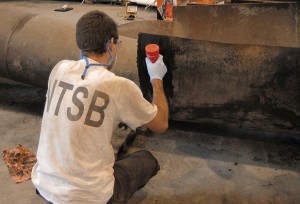February 2011, Vol. 66 No. 2
Newsline
NTSB Issues Update On San Bruno Pipeline Investigation

The investigative group conducting the metallurgical examination of the pipe is chaired by the National Transportation Safety Board and includes technical experts from the Pipeline and Hazardous Materials Safety Administration (PHMSA), the California Public Utilities Commission (CPUC) and Pacific Gas & Electric (PG&E).
What follows is factual information that has been developed at this early point in the investigation.
PG&E survey sheets and charts for the rupture location indicate that the pipeline was constructed of 30-inch-diameter seamless steel pipe (API5L Grade X42) with a 0.375-inch thick wall. Evidence obtained so far, however, indicates the pipeline in the area of the rupture was constructed, at least in part, with seam-welded pipe.

After the ruptured pipe surfaces were thoroughly surveyed, all of the asphalt coating was removed and the pipe was cleaned to allow for visual inspection and nondestructive testing (NDT) of the surfaces. The condition of the welds was evaluated by visual inspection, x-ray radiography and magnetic particle inspection to document any defects or irregularities in the material. Pipe thickness surveys were conducted using ultrasonic thickness testing. Additionally, the pipe pieces were laser scanned for complete dimensional documentation.
The fracture surfaces of the ruptured pipe pieces were examined using low-magnification optical microscopes. Samples were then cut from the ruptured pipe pieces for detailed metallurgical examination. The fracture surfaces were examined under both high-magnification optical microscopes and scanning electron microscopes to identify and document specific fracture features. Metallurgists are currently in the process of using this information to determine the direction of crack propagation and the fracture origin and failure mechanisms.
Investigators found that while the longitudinal seams on some of the pipe segments were fusion-welded from both inside and outside the pipe, some were fusion-welded only from the outside of the pipe. In order to understand this variance, investigators are in the process of researching pipe welding standards and practices in effect at the time the pipeline was installed in 1956.
The outer surfaces of the ruptured pipe pieces revealed no evidence of external corrosion. No dents, gouges, or other physical indications consistent with excavation damage were observed. Additionally, no physical evidence suggests that a pre-existing leak occurred in the ruptured pipe pieces.
The following laboratory work is ongoing:
• Chemical compositional analysis and mechanical property testing of samples taken from the ruptured pipe pieces; and
• Evaluation of environmental factors at the accident site.
The investigation is still in an early phase and there is much factual information to be developed before the Safety Board is positioned to determine the probable cause of the accident.
Other areas that investigators are examining include pipeline control and operations, regulation and oversight, human performance, survival factors and pipeline maintenance and records.




Comments